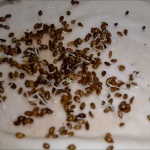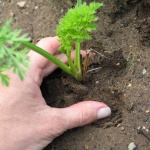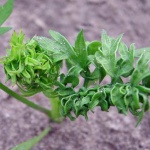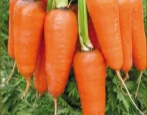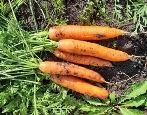
- Authors: Maksimov S.V., Klimenko N.N., Simanova A.F.
- Year of approval: 2008
- Appointment: for fresh consumption, for canning, for freezing, for bundled products, for making juice
- Leaf rosette shape: semi-spreading
- Leaves: medium to long, green, moderately dissected
- Weight, g: 80-110
- The form : fusiform with slightly pointed tip
- Taste qualities: good and excellent
- Composition : dry matter 11.6%, total sugar 6.4-7.0%, carotene up to 16.6 mg per 100 g of raw matter
- Ripening terms: mid-season
To grow delicious carrots in a garden bed, you need to choose a variety that adapts to the climatic conditions of the zone where the vegetable is planned to be planted. For the Central region, the mid-season carrot variety Yaroslavna, created by domestic scientists, will be an excellent option.
Breeding history
Carrot Yaroslavna is the result of the work of a group of Russian breeders of the agrofirm "Poisk" S. V. Maximov, A. F. Simanova and N. N. Klimenko. This variety of carrots is cultivated in the Central and Central Black Earth regions. You can grow a vegetable both in a small garden bed and in farm fields.
Description of the variety
Yaroslavna's carrot is a plant with a powerful semi-spreading rosette. The leaves are rather elongated, with a uniform emerald green color, medium dissected. Foliage has no specific aroma. Yaroslavna belongs to the Flakke variety. The immersion of the root crop in the soil is deep, so harvesting is easy and convenient.
Characteristics of the appearance of the plant and root crops
Yaroslavna is a medium-fruited variety. A vegetable ripens up to 80-110 g, 18 to 22 cm long. Carrots grow in the same size and shape. The shape of the root crops is fusiform with a slightly pointed tip, sometimes cylindrical with a rounded end. Ripe carrots are evenly covered with a red-orange color. The surface of the root crop is smooth, shiny, without tubercles and depressions.
Carrots are easily transported, and can also be stored for a long time without loss of taste and marketability. It is recommended to store carrots in a dark, dry and cool place, where the temperature is not higher than + 2 ... + 4 °.
Purpose and taste of tubers
Yaroslavna's roots are characterized by excellent taste. The red-orange flesh has a firm crunchy and juicy texture without fibrillation and wateriness. The taste is dominated by bright sweetness, perfectly combined with the classic carrot aroma. The core of carrots is very thin, not differing in color from the pulp of a vegetable. The advantage of the carrot variety is its rich vitamin composition, which contains carotene, sugar, and trace elements.
The harvested crop is widely used in cooking: carrots are added to many hot and cold dishes, when canning other vegetables, in fresh salads, and the variety is also suitable for processing into juice. In addition, the vegetable is frozen, stored throughout the winter, and used for bundled products.
Maturation
Yaroslavna is a mid-season variety. The growing season lasts just over 4 months: 125–135 days. You can taste a fresh vegetable already at the end of July, and the massive return of root crops falls on the period from August to September.
Yield
Carrot yields are good. On average, about 4 kg of root crops can be harvested from 1 m 2 of plantings. When growing a crop for commercial purposes, 206-420 centners of vegetables are dug out from 1 hectare of plantations.
Growing and care
The vegetable is cultivated by the seed method. Sowing seeds in open ground is carried out in the first half of May. To do this, shallow grooves (1–2 cm) are made in a previously prepared area, where seeds are planted. The distance between the rows is usually 20 cm.The sowing is carried out according to the scheme 20 / 30X5 cm.
The optimum air temperature for sowing is considered to be + 8 ... + 10 °. Good precursors for carrots are cucumbers, legumes, and onions.
Crop care implies regular watering, loosening and weeding, several thinning per season while maintaining a distance between plants of 4–6 cm, fertilizing 2 times during the growing season (nitrogen and phosphorus-potassium), prevention of viruses and insect infestations. It is also worth noting that the variety is suitable for winter sowing, which is carried out from late October to early November (until the temperature drops to + 5 °).
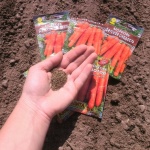
Carrots are one of the most unpretentious crops in terms of growing conditions; they can endure a short drought and a short cold snap. However, to get tasty and large root crops, you should adhere to the basic rules for planting carrots.


Soil requirements
The vegetable grows and ripens comfortably in light nutritious loamy and sandy loamy soils with good air permeability. In addition, the soil should be moist and with a neutral, even slightly reduced acidity index. Planting in lowlands with swampy soils is not recommended.
Required climatic conditions
Yaroslavna's vegetable, like most of its relatives, prefers areas on a small hill or plain, where it is very sunny, warm, moderate moisture, and also there is no stagnation of water and dampness.
Disease and pest resistance
Thanks to its good immunity, Yaroslavna's carrots are practically not susceptible to diseases. Culture can only get sick if agricultural technology is violated. The most dangerous insect attacking the plant is the carrot fly. In addition, the roots are absolutely crack-resistant.
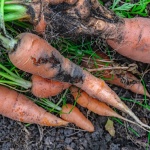
Carrots grow in almost any garden. There is an opinion that this culture is very resistant to all kinds of diseases and pests, but this is not the case. Without proper care, carrots become susceptible to all kinds of infections and are affected by harmful insects.


